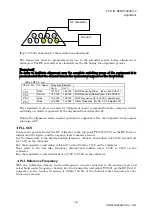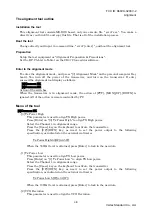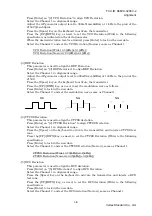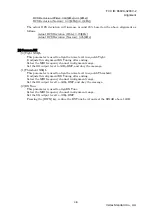
FCC ID: K66VX-3200V-2
Alignment
3/6
Vertex Standard Co., Ltd.
(Fig 2: J1502 connection for the modulation adjustment)
The transceiver must be programmed for use in the intended system before alignment is
attempted. The RF parameters are loaded from the file during the alignment process.
[Important]
In order to facilitate alignment over the complete switching range of the equipment it is
recommended that the channel data in the transceiver is preset as the chart below.
Table.1 RF Ch. List
Frequency(Simplex)
RF Ch. list
Ch. Space
Ver. A
Ver. C
Ch 1
Wide
147.100
162.100
MID Frequency(Wide)
[use in the SVC47]
Ch 2
Narrow
147.100
162.100
MID Frequency(Narrow) [use in the SVC47 ]
Ch 3
Wide
134.100
148.100
LOW Frequency [for PLL VCV adjustment]
Ch 4
Wide
159.900
173.900
HIGH Frequency [for PLL VCV adjustment]
The alignment mode is accessed by “Alignment mode” command from the computer whilst
switching on. And it is operated by the alignment tool automatically.
During the alignment mode, normal operation is suspended. Use the alignment tool program
running on PC.
・
PLL VCV
Connect the positive lead of the DC voltmeter to the test point TP1007 (VCV) on the RF-Unit, as
indicated in the figure, and the negative lead to chassis ground.
Set the transceiver to the high band edge frequency channel, then adjust coil L1016 on the Unit
for 7.40V on the voltmeter.
Key the transmitter, and adjust coil L1017 on the Unit for 7.40V on the voltmeter.
Next select to the low edge frequency channel and confirm above 2.00V to 2.50V on the
voltmeter.
Key the transmitter, and confirm above 2.00V to 2.50V on the voltmeter.
・
PLL Reference Frequency
With the wattmeter, dummy load and frequency counter connected to the antenna jack, and
select band center frequency channel, key the transmitter and adjust TC1001 on the RF-Unit, if
necessary, so the counter frequency is within 100 Hz of the channel center frequency for the
transceiver version.
5
4
3
2
1
9
8
7
6
AF Generator
Ground
























